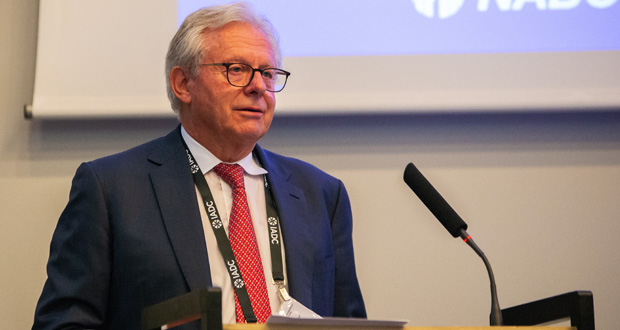Technology, energy transition will be key drivers in industry’s push for sustainable future

By Stephen Whitfield, Associate Editor
With oil prices trading in the triple-digits for much of 2022 so far, the near-term future of the drilling industry looks optimistic. Speaking at the 2022 IADC World Drilling Conference in Paris on 22 June, Siggi Meissner, President – Energy Transition and Industrial Automation at Nabors, said that – as long as the industry can maintain its focus on capital discipline – he believes the current upward trend could continue for the next several years.
The key is that companies must not get distracted by the short-term gains possible right now, Mr Meissner said, and instead focus on developing business models that will be sustainable for the long-term future. This means the industry will have to work even harder to achieve the next step-change in efficiency, while making its work environment safer and reducing emissions from its operations.
At Nabors, its formula for sustainable value creation focuses on three key areas: technology, the energy transition and talent, Mr Meissner said. For technology, he cited process automation, robotics and digital optimization as the three main drivers of drilling performance in a sustainable future. Not only can process automation help drillers achieve repeatability and consistency, but it can also industrialize best practices and ensure that drill plans are optimized.
Nabors’ Smart Suite of integrated automation systems is an example of effective process automation, he added. Programs like SmartNAV, an automated directional guidance program; SmartSLIDE, a directional steering control program; and SmartDRILL, an automated drilling activity sequencer, all operate within SmartROS, an operating system that automates and digitalizes drilling processes on the rig. When coupled with robotics, these kinds of technologies will enable more precise control of rig equipment, delivering a step change in performance and safety.
Robotics has already played a significant role in the operation of Nabors’ PACE-R801, a fully automated land rig that was deployed last year for ExxonMobil in the Permian Basin. The rig, which has so far recorded 2 million ft drilled, tripped and cased in the Permian, utilizes the Smart Suite portfolio along with robotic systems to create an unmanned rig floor. It proves the viability of full automation on the rig floor, Mr Meissner said, noting that crew members who would normally be working in the red zone have been moved to other value-added tasks, such as service, maintenance, inspections and rig moves.
“When you look at the rig floor, it’s about 70,000 lbs of moving loads hanging over our heads. We are probably the only industry that allows our people to work underneath and between moving loads like this,” Mr Meissner said. “Rig 801 was a major milestone for Nabors and ExxonMobil, but also for the industry, because it proved that full automation was possible without compromising efficiency, and we successfully removed personnel from the rig floor.”
The energy transition is also a major area of focus for Nabors. While oil and gas will continue to play a significant role in the energy mix moving forward, the company also recognizes that drilling contractors and service providers must seek ways to enter the low-carbon market. Last year, Nabors introduced Nabors Energy Transition Solutions (NETS), a portfolio of technologies designed to drive energy efficiency and reduce emissions for both the company and third-party customers. The portfolio includes, among other things, proprietary emissions reporting and analytics software, engine management controls, energy storage systems and carbon capture technology.
Nabors is also branching into geothermal drilling, partnering with outside-industry companies to evaluate business models. The focus is on advancing technologies that can help overcome historical hurdles for wide-scale commercial geothermal development, such as deep hard-rock drilling systems, high-temperature drilling equipment and advanced stimulation techniques.
“All sources of energy will be required to meet the needs of tomorrow, and we will require more of them, including renewables and hydrocarbons. We need to focus on the things we can control, and then work to provide leadership for others to decarbonize at the same time. This space is emerging, and it will provide opportunities to branch out and offer new services,” Mr Meissner said.
Technology and low-carbon developments will play a key role in attracting new talent into the industry. Mr Meissner acknowledged that the industry has a perception problem, particularly with young workers, saying that today’s workforce is looking at “products with a purpose.” By showing its progress on digitalization and automation, and by promoting efforts around sustainability, oil and gas can better position itself in the talent race.
“Our industry has a great story concerning the proven ability to produce more with less of everything, but we must work on our reputation. We need to attract the new workforce to our industry and gather community support. This will require us to better explain the key role we play to provide low-carbon energy security for the future,” Mr Meissner said.




